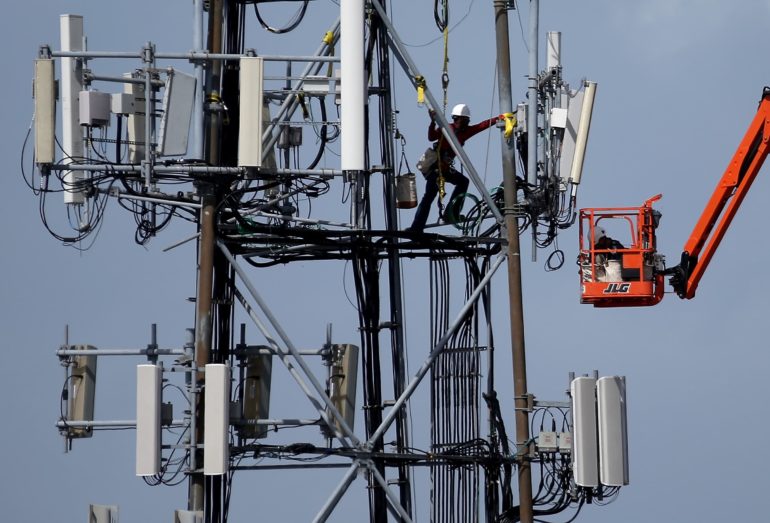Every time someone accesses the internet through their smartphone, their wireless carrier transmits that data through the airwaves on frequencies that only it has the license to use.
In the coming weeks, licenses to use some of of the most valuable frequencies will be assigned to the highest bidder. Whoever wins will almost certainly use them to build out a faster, more powerful 5G network, changing the competitive dynamics of the telecom industry.
Earlier this month, the Federal Communications Commission announced that bidders have bid $80.9 billion on 280 megahertz of airwave licenses, or spectrum, in what’s referred to as Auction 107.
After 97 rounds of bidding, the total was significantly higher than the $20 billion to $30 billion range most outside observers predicted last summer, and underscores how critical this auction is for telecom companies.
“Once these 5G networks deployed on this mid-band spectrum are rolled out, the performance jump is going to be so dramatic, that if carriers are not in that game they’re going to get left behind,” said Doug Brake, broadband policy director at the Information Technology and Innovation Foundation, a think tank.
The winners of the auction aren’t public yet. Verizon, AT&T, T-Mobile and other parties involved in the auction are in a quiet period where they can’t comment until it’s final and down payments have been paid. A notice issued by the FCC on Jan. 26 reminded applicants that they can’t legally talk about any non-public information such as who’s won or lost.
The FCC also said the auction is entering a second phase in which the winners will get to pick the exact regions and blocks of spectrum they want. The bidders have won licenses, but the specific assignments aren’t final yet. The results are expected to be released in a few weeks.
Who’s buying
The auction is a big deal for Verizon, T-Mobile, and AT&T, the big three U.S. wireless companies. All three are in the process of building out 5G networks.
The FCC is involved in spectrum allocation to prevent interference, or when two groups are using the same wavelengths at the same time, making it less effective. That’s why the FCC is running this auction, which is intended to make sure that the groups that win have the capital to actually use the spectrum. Most of the proceeds go to the U.S. Treasury.
Not all wavelengths are created equal. The highest frequencies only travel short distances but can transmit huge amounts of data with recent advancements in antennas and modems. The lowest frequencies can travel long distances but are less well-suited for pumping large amounts of data.
The C-Band wavelengths that are up for auction are in the middle. It’s actually called mid-band spectrum. Some call it “goldilocks spectrum” — as in, it’s just right for 5G.
“If you’re Verizon, you now have the opportunity to get the spectrum you need because you don’t want to lose the beachhead of being perceived as the leading company. They kind of dominated the LTE or the 4G world,” said Walt Piecyk, co-founder of LightShed Partners, which closely follows spectrum auctions. “Are you going to let T-Mobile, or even AT&T take over the mantle as being the 5G network of choice?”
T-Mobile acquired licenses for a different block of mid-band spectrum through its merger with Sprint. So it doesn’t need to win this auction as much as Verizon does. But it’s still expected to be a bidder for a variety of reasons. If it wins, that means that its rivals didn’t. Even if it doesn’t win, bidding could increase the price.
AT&T needs to win, too. But it has been spending a lot in recent years. In 2018, it paid over $85 billion for Time Warner, which included HBO.
This spectrum would also be a large purchase, but at the same time, AT&T also needs mid-band spectrum to build the wireless network that powers its cash flow. Raymond James analyst Frank Louthan said in a note earlier this month that if AT&T spends $23 billion on spectrum, its balance sheet could “spook investors.”
Cable companies like Comcast, Charter and Cox are also registered to bid. Charter and Comcast formed a joint venture called C&C Wireless Holding Company to bid on the frequencies. But the spectrum is less strategic for broadband companies and they are less likely to pay eye watering prices for it.
One wildcard is Dish, whose chairman Charlie Ergen has shown a proclivity for snapping up spectrum and bidding up prices in the past.
That’s not every possible winner out of the 74 entities that registered to bid in the auction, but those are the big ones. No big tech companies publicly registered to bid. There’s an outside possibility that a tech giant has been quietly participating in the auction through one of the entities, but that’s very unlikely, said Piecyk.
What they’re buying and what’s next
The spectrum that’s up for auction is between 3.7 GHz and 3.98 GHz. But it’s not all being sold at once. It’s split into smaller 20 MHz blocks, and further divided into 406 geographic regions. All together, there are 5,684 licenses up for grabs.
In the second phase of the auction, starting February 8, parties that won bids during the first part will participate in a process to divvy up these blocks.
It’s a complicated process. A tutorial slide deck for parties participating in the so-called “assignment phase” is 44 slides long, and that’s in addition to a 58-page user guide for the software needed to submit bids.
One key aspect is that there’s one range of spectrum in the auction, the “A block,” that’s more valuable than others because the winner can start building a network on those airwaves as soon as the end of this year. Other parts of the C-band won’t be ready for networks until 2023, and time matters.
The spectrum up for auction was originally assigned to satellite operators, which are moving to the 4.0 to 4.2 GHz range. The satellite companies that originally were assigned the spectrum will receive multi-billion dollar incentive payments and relocation costs to help them get off their spectrum more quickly.
Once the assignment phase is completed in the coming weeks, the winners will be announced.
Then the hard work starts: actually building the network, which includes finding cell sites, installing equipment, and marketing the new network to potential customers.
All of that costs a lot of money, on top of the money the winner will have already committed to pay for the spectrum. Investors will need to closely watch whether the winners issue debt or raise money in other ways to fund the network buildout.
The 5G networks on the C-band spectrum won’t come online overnight. The earliest any of the blocks will be ready for deployment is at the end of this year. But when they’re built, phones will be ready for them — Apple’s iPhone 12 supports the specific frequencies up for grabs in this auction, for example.
But this spectrum purchase isn’t a short-term commitment for the winners. The licenses are a key strategic asset in the wireless industry that could shape the competitive landscape for years to come.
“They’re all fighting to get a sizable stake to compete for the next 10 years,” Brake said.



